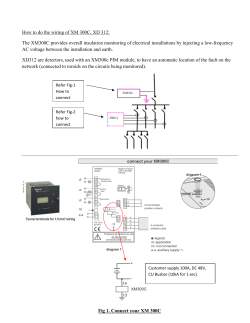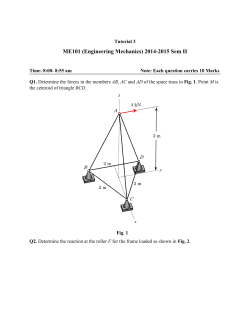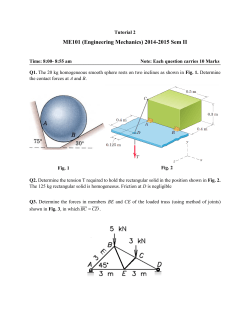
Means for moving heavy loads
nited States [ 72] Inventor atent 1111 3,622,073 3,023,826 Alexandre J. Cayre Codalming, England [21 ] Appl. No. 876,249 [22] Filed [45] Patented [73] Assignee [32] Priority [33] 13 l ] Nov. 13, 1969 Nov. 23, 1971 RFD - GQ Limited Nov. 18, 1968 Great Britain 54,673/68 U.S.Cl ...................................................... .. 238/10 R, Int.Cl ....................................................... ..E0lb23/l0 [50] Field of Search. 254/2; 238/10,l3,10 R;180/125; 152/333; 14/27, 28, 29; 280/D1G. 7 156] 2,423,832 References Cited UNITED STATES PATENTS 7/1947 V‘Gcaron ..... . . . . . . . .. 280/D1G. 7 238/13 152/333 3,104,496 3,191,706 9/1963 6/1965 180/125 180/125 Macks ........ .. Petersen ......... .. 3,21 1,425 10/1965 Grevlich et al. 3,411,637 11/1968 3,513,934 5/1970 254/2 (2) Lely .... ..-. . . . . . . . Crowley . . . .. 238/13 ............... .. 180/125 Primary Examiner- Drayton E. Ho?man 14/28, 180/125, 254/2, 280/D1G. 7 [51] Larson . . . . . . 3/1903 Sheeler 7/1934 Brown Assistant Examiner-Richard A. Bertsch Attorney-Watson, Cole, Grindle & Watson [54] MEANS FOR MOVING HEAVY LOADS 4 Claims, 3 Drawing Figs. [52] 3/1962 722,256 1,966,428 ABSTRACT: Means for moving a heavy load comprising an vin?atable support to be placed under an accessible part of the LOAD, a plurality of in?atable track elements to be arranged in abutting end to end relationship to provide an extended length of track over which the support can be dragged to move the load and anchoring means for securing the track element to the ground, the support and the track elements being of a ?exible material and capable of expansion from an inoperative de?ated condition to an operative extended condition by the “114/21: admission ofpressure ?uid thereto. 13 '12 . /[////// 3 2 t. // @7 /7! 1 3,622,073 MEANS FOR MOVING lI-IEAVY LOADS This invention provides means for moving a heavy load, comprising a support to be placed under an accessible part of 2 end to end or one above another to give the necessary length or height as the case may be. Each of such elements, when made expansible, and each of the compartments into which it is preferably divided for safety purposes, is provided with its the load and a track over which the support can be dragged to 5 own valve or valves for controlling admission of pressure ?uid move the load, the support or the track (and preferably both these components) being in?atable so that in?ation thereof raises the load from the ground or other supporting surface prior to movement of the load on the support along the track. This invention relates to means for moving heavy loads, par ticularly loads such as crashed aircraft for example. When an aircraft crashes at an airport and in doing so blocks a runway, it is usually imperative that the obstruction be removed as quickly as possible. This frequently means that the aircraft is simply dragged away along the ground, with the result that considerable additional damage may be caused to the wings and fuselage. Moreover because of the high degree and, except in cases where a solidifying ?uid is used, withdrawal thereof. Two embodiments of the present invention will now be described in greater detail and by way of example, with reference to the accompanying diagrammatic drawings, in which: FIG. 1 is a plan view of spaced supports and tracks in ac cordance with the present invention, in use during the removal of a crashed aircraft; FIG. 2 is a section through the aircraft wing on the line II II of FIG. 1, showing the underlying support and track of a ?rst embodiment, and of friction between the aircraft and the ground, very powerful FIG. 3 is a view similar to FIG. 2 but of a second embodi towing vehicles are necessary. Alternatively, crashed aircraft ment of the invention. are sometimes ?rst raised from the ground and then lowered 20 In the situation diagrammatically represented in FIG. I, use onto trucks for removal, but this is a relatively slow process. is made of two parallel tracks 1, each below a different one of It is an object of the present invention to provide means for the wings of the aircraft. Each track is made up of a number of moving a heavy load, and particularly although not exclusively a crashed aircraft, which means is capable of rapid operation wherein, moreover, the likelihood of damage to the load dur ing movement thereof is virtually eliminated. According to the present invention, means for moving a heavy load comprises a support to be placed under an accessi ble part of the load, and a track over which the support can be dragged to move the load, the support or the track being an in in?atable elements la placed end to end and ?xed to the ground by anchoring means at 2. The individual elements la are each internally subdivided into compartments and each such compartment has its own valve 3 for controlling the ad mission of pressure gas and the withdrawal thereof. Similarly, each in?atable support 4, which is lashed to the appropriate aircraft wing by lines 5, is internally divided into compartments by partitions 6 and each such compartment has ?atable component made at least partly of ?exible material its own valve 7 for the admission and subsequent withdrawal and capable of expansion from an inoperative de?ated condi of pressure gas. As will be seen best from FIGS. 2 and 3 each tion to an operative expanded condition by the admission of support 4 is of general mattress shape when expanded. In FIG. _ pressure ?uid thereto. Preferably, but not necessarily, both the support and the 35 2 the outer wall of the support 4 is shown broken away at the right-hand end to reveal the internal structure of the support; track are in?atable components capable of expansion as it will be seen from this FIG. that the support is made of a so aforesaid. called composite fabric as de?ned above, the top and bottom The pressure ?uid used to cause expansion of the support fabric layers of the support being tied together by a multiplici and/or track may be a gas (for example, air) or a liquid (for ty of retaining threads 8. The tracks 1 are of the same internal example, water or liquid, soap) or a combination of the two; and the pressure fluid may be a liquid, such as a settable resin for example, which will solidify after injection into the in?ata structure. In the embodiment shown in FIG. 2, the bottom surface of the support 4 and the upper surface of the track I are respec ble component or components. The support and the track may both be made from a "com 45 tively covered by layers 9 and ll of nylon. Because of the low coe?icient of friction of this material, the support 4 can be posite fabric," by which is meant a known material of the kind dragged over the track 1 with the minimum of friction. In the embodiment shown in FIG. 3, however, the layers 9 and 11 are omitted and their purpose is served by the inter When the support and track are both to be in?ated by a gase 50 position of rollers 12 between the upper surface of the track and the bottom surface of the support 4. The rollers 12 are ous pressure ?uid, the layers of the composite fabric are themselves in?atable and are articulated by links 13. selected so as to be gas-impermeable. ' In operation, whichever of these two embodiments is to be However if liquid soap, for example, is to be used as the employed, the or each track 1 is laid down in its de?ated con medium for expanding the support, then the surface of the support that contacts the track as the support is dragged 55 dition under an accessible part of the aircraft and the as sociated support 4, also de?ated at this stage, is placed on top thereover is preferably made of porous material (either in of the track; if the FIG. 3 embodiment is to be used the rollers herently porous or rendered so by perforation) so that liquid soap may exude from the expanded support and act to reduce 12 (also unin?ated) are, of course, placed on the track before the support is positioned. The track and support (and also the friction during dragging; alternatively, but less desirably, liquid soap can be used to expand the track, in which case the 60 rollers 12, where applicable) are then in?ated by the admis sion of pressure gas until they raise the aircraft from the upper surface of the track is preferably made of porous ground, the components thereby jointly acting as a jack. The material for the same friction-reducing purpose. Thus when liquid soap is used as the pressure ?uid, it can be made to per support can then be dragged over the track, in the direction of form the two-fold purpose of expanding the in?atable com the arrows in FIG. 1, bearing the load with it. The pulling force ponent or components and reducing friction therebetween. 65 necessary to move the support relatively to its respective track Alternatively other friction-reducing means may be used. can be provided by any known means, for example a towing vehicle. For example the contacting surfaces of the track and support may be formed from, or provided with a layer of, a material Although FIG. 1 shows a pair of spaced tracks, each with its having a low coefficient of friction, such as nylon for example. own load-bearing support 4, it will be appreciated that a single As a still further alternative, casters, balls or rollers 70 track and support may be sufficient for some loads; or alterna (preferably in?atable rollers) may be introduced between the tively that several supports may be employed on a single broad lower surface of the support and the upper surface of the track. track. It will be further appreciated that means according to the Each of the components (that is the support and track) may present invention can be introduced into locations which are be made up of a number of standard elements joined together 75 inaccessible to conventional load-moving apparatus such as comprising at least two superimposed layers of fabric tied together by retaining threads for the purpose of preventing separation of the layers beyond a predetermined amount. 3 3,622,073 4 cranes for example. Moreover in?ation of the track, as in the preferred embodiments described above, provides an even regular surface over which the load can be moved, however operative expanded condition by the admission of pressure ?uid thereto, and rollers being interposed between the upper surface of the track and the bottom surface of the support. rough and irregular the underlying terrain. 2. Means according to claim 1, wherein the interposed rol What I claim as my invention and desire to secure by Letters Patent is: 1. Means for moving a heavy load, comprising 5 support to be placed under an accessible part of the load, a plurality of lers are in?atable. partly of ?exible material and each being separately capable to control the admission of pressure ?uid thereto. 3. Means according to claim 1, wherein the support is inter nally partitioned into a number of compartments, each such compartment having a separate valve to control the admission track elements adapted to be arranged in abutting end-to-end relationship to provide an extended length of track over which 10 of pressure ?uid thereto. 4. Means according to claim 1, wherein the track is made up the support can be dragged to move the load and the track ele of a plurality of standard elements placed end to end, each ments having anchoring means for securing the elements to such element being internally partitioned into a number of the ground in said end-to-end relationship, the support and the compartments‘and each compartment having a separate valve track elements being in?atable components made at least of expansion from an inoperative de?ated condition to an it 25 30 35 40 45 55 65 70 75 It ll It i
© Copyright 2025









